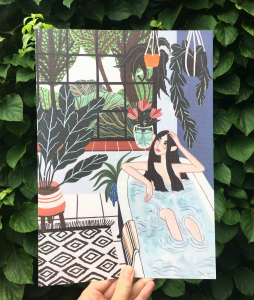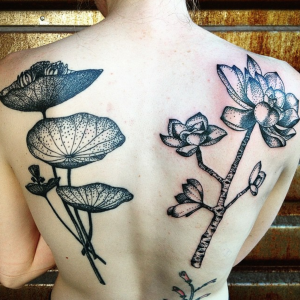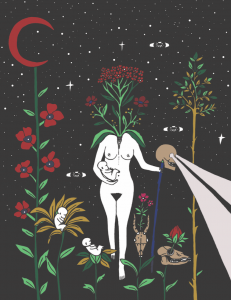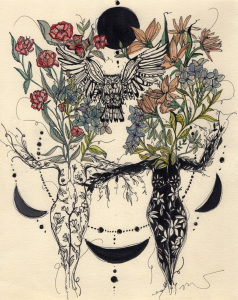“Real isn’t how you are made,’ said the Skin Horse. ‘It’s a thing that happens to you. When a child loves you for a long, long time, not just to play with, but really loves you, then you become Real.’
‘Does it hurt?’ asked the Rabbit.
‘Sometimes,’ said the Skin Horse, for he was always truthful. ‘When you are Real you don’t mind being hurt.’
‘Does it happen all at once, like being wound up,’ he asked, ‘or bit by bit?’
‘It doesn’t happen all at once,’ said the Skin Horse. ‘You become. It takes a long time. That’s why it doesn’t happen often to people who break easily, or have sharp edges, or who have to be carefully kept. Generally, by the time you are Real, most of your hair has been loved off, and your eyes drop out and you get loose in the joints and very shabby. But these things don’t matter at all, because once you are Real you can’t be ugly, except to people who don’t understand.” -Margery Williams, The Velveteen Rabbit
I love this little exchange. It holds such deep wisdom. I particularly love that line: “When you are Real you don’t mind being hurt.”
Our sensations, emotions, and thoughts are what make up our aliveness. It’s a lovely little trinity that brings a lot of richness when all three parts are working together. You get a whiff of something lovely (sensation), and instantly feel a little joy (emotion), because it reminds you of something pleasant from long ago (thought). Those moments are some of the best that aliveness has to offer. They’re what keep us willing to tolerate pain. What makes it tough is when the pain begins to outweigh the pleasure. Then we start to shut off, and that natural, flowing cycle instead becomes a pattern of tension.
Whether you’ve experienced trauma or the more everyday hardships, there’s some work to do to in order to awaken and turn back on. Loss or reduction of connection to your body is something to wage war against the moment you notice it occurring. Because as we turn off to sensation after experiencing too much unpleasantness, we also turn off to the good stuff. Numbness/ shutting off/ dissociation is a brilliant mechanism when it’s needed, but we often overuse it. Sometimes we turn off to just a few avenues of experience, but sometimes we chronically turn off to the body. And then we turn off to living. Worse, turning off is too often reinforced. “You’re just being sensitive.” “That’s just the way it is.” “Those are just feelings.” “Men don’t cry.” “Be rational.” That kind of thing doesn’t exactly invite us back into feeling. But your body doesn’t go away just because you’ve begun to ignore it. Your body is with you all of the time. Let yourself be with it by getting really good at knowing how.
This trinity must be supported by two very important things: safety and groundedness. You must be present and alert, and what you are present for must be adequately safe. Our natural state is to be open to experiencing things. But after we’ve had so many painful experiences that we’ve shut off, it takes active effort to open back up. And opening back up to what you feel can be very scary. Not only because heretofore unfelt sensations were only ever waiting for your gaze to fall back upon them, but because much of what one might consider “good” sensations are themselves a little unpleasant. Even anticipation, which many think of as a pleasant state, is pretty uncomfortable- a sort of pleasing agony.
So to begin, get damn good at getting grounded. Groundedness means being able to feel your body really well- the points of contact, your heart rate, your breathing, your muscle tension. When I feel grounded, I feel slower and very aware of my legs. A lot of clients have described it as light but weighted, or pleasantly anchored.
Next is being present, which comes pretty darn naturally once you’re grounded. Presence means being able to notice what’s happening around you- the scents, sounds, tastes, sights and sensations. As I’m writing, I can hear the clickity clack of the keyboard, the crickets outside, the whir of my server. I can taste the chocolate I was eating a bit ago. The laptop seems very bright to me now that I’m really paying attention, and I’m also aware of my peripheral view- the lamp and its light reflecting on the table, an orchid, my red pillows. I feel the laptop on my thighs, my fingernails tapping the keys, the table against my calves where I’m resting my legs, my chest expanding and contracting with my breath, and my stomach beginning to tingle.
You’ll notice that everything I’ve named is fairly neutral or even pleasant. This is a huge part of the safety that I named. If what I had to open up to was largely unpleasant, you’d have a hard time convincing me to stay open.
Even feeling extreme joy and happiness can be tough. When something moves me, my chest swells. I have to breathe deeply to expand- not because my chest contracted, but because I have to make room for this new powerful experience. It’s a little uncomfortable. But it’s great. I believe that this may be the sensation of growth itself. Again, not necessarily pleasant, but very alive.
Also notice that I didn’t interpret any of my sensations for you, though I was tempted to when I noticed my stomach beginning to tingle. A huge part of re-awakening to your body is not making interpretations about what you feel. Let it be simple, because it is simple. Your body will tell you your truth if you get out of its way. We get too used to our own lens, and bring in interpretations too quickly. This will be difficult. We are so adept at deciding things. But if you want to make a shift, get really curious about how you perceive things.
“If you are distressed by anything external, the pain is not due to the thing itself, but to your estimate of it; and this you have the power to revoke at any moment.”
-Marcus Aurelius
It’s this reception of an experience that is key. We are constantly presented with opportunities to feel, but we don’t always take them in. Reception of an experience is a muscle to exercise repeatedly so that you can get even a short ways down the path to mastery, which I’ve come to suspect isn’t attainable (something I consider a very good problem). You need only make a little room to start, and the sensation will begin to flow in. The harder work is letting what feels good have as much of your attention as the rest. This is the chief reason to surround yourself, not with drama (which can be confused for aliveness), but with what you love and what brings you joy. You should be awakening to plenty of your favorite colors, music, art, and foods. Walk outside, and you will find plenty to feel and taste and see and hear. If your particular patch of nature is thin on beauty, there is always the sky. Author Karen Connelly writes, “When I let this body outside for a walk, it awakens.”
Again, opening back up does mean risking pain. And there are so many types of it! Physical, emotional, mental. Intentional and unintentional. Direct and indirect. And then there’s the particular pain of not knowing or of believing that you’ll never know. But even pain can bring access to the Self. Yet before one can even consider such a thing, pleasure must loom larger. But by its very nature, pleasure will not force itself upon us. It wants an explicit invitation, which means that we must have a particular object of desire. Surround yourself with the things you know you love. And be open to finding plenty more. These are often blessedly easy to spot, but terrifying to seek. Extend your openness to learning new ways of seeking. Stay reasonably open to the unknown.
Fortunately, the unknown pulls at us, even if we try to ignore it. Some of us even go searching for it, because it holds tremendous power. Venturing into the unknown we can find exactly what we need- if at first only by projecting into it. We are marvelous at projecting our unknown needs through our fears. Get curious about how you think. Know your go-to lenses. Find your blindspots, and know that there are always more. Consider your stories about what you do not yet fully understand, or what you fear. The concept of the sterile or fertile void is a particular potent thing to ponder. When you stare up into the night sky, imagining all of the black space expanding into the absolute unknown, what do you think about? What sensations are attached to those thoughts? What emotions?
We often refuse the very thing we need by denying its existence. It didn’t exist before, so why should we believe that it does now? This is why us therapists pester you with that damn question, “What would it be like if…” The intent is to make room, to open, to let in. Practice. Practice on the fun stuff. And then keep practicing.
I’ve been delighted to find, through my own practice as well as through supporting clients, that as the body is more thoroughly inhabited, it only continues to expand in ability to contain and enjoy. It is a grand hotel, which grows in size and richness with its constant stream of enthusiastic guests.






